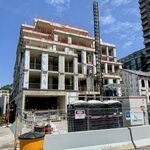It appears that effectively, 4 options for Finch-Sheppard corridor are being discussed in this thread, rather than just 2. Therefore, let me upgrade the classification:
1A. LRT solution, with Finch W LRT and Sheppard E LRT connected via Finch E and Seneca College. Sheppard subway is not converted to LRT, but is not extended.
1B. LRT solution, with Finch W LRT and Sheppard E LRT connected via the tunnel of former Sheppard subway. Sheppard subway is converted to LRT.
2A. Subway-LRT combo solution, with Finch W LRT ending at Yonge, Sheppard subway extended and running from Downsview to Kennedy / Agincourt, Sheppard E LRT running east of Agincourt. Subway from Agincourt to STC deferred.
2B. Subway-LRT combo solution, with Finch W LRT ending at Yonge, Sheppard subway extended and running from Downsview all the way to STC. No Sheppard E LRT (bus service on Sheppard east of Agincourt).
My take on those options:
Is there a case for Sheppard subway extension?
Based on ridership projections only, Sheppard subway is not required as LRT will be able to handle the demand.
However, choosing technology just on ridership projections is too simplistic. Several factors have to be taken into account: ridership for sure, but also speed, growth potential, and network impact of the given route.
There is no alternative fast E-W route at the Finch/Sheppard "altitude". (In contrast, Eglinton competes with Bloor subway for some trips, and has CPR's North Toronto rail not far away.) Apparently, a very good growth potential exists on Sheppard E east of Don Mills. Finally, the westerly extension of Sheppard subway would create a link between Yonge and Spadina lines, hence: a) Passengers will be able to quickly move between the two lines; b) Trains can shortcut from Wilson yard to the north of Yonge line.
Speaking of costs, subway will obviously be more expensive, but the creation of a continuous LRT line won't be cheap, either. Adding up $700 m for Finch W LRT, $800 m for Sheppard E LRT, and at least $500 m to connect them, we need about $2 B for the the whole corridor. (I do not actually have estimates for the connecting section, but it will be a nontrivial amount. For example, Sheppard West between Yonge and West Don river is too narrow for surface LRT.)
Subway-LRT combo (let's estimate 2A) will require about $3.7 B ($ 2.5 B for subway extension, $700 m for Finch W LRT, and $500 m for shorter Sheppard E LRT).
So, I take 2 over 1.
Is there a need for Sheppard E LRT east of Kennedy, in case Sheppard subway is extended?
I find it surprising that several correspondents dismiss the potential of that LRT route. If it offers a short ride to a popular subway line (extended Sheppard) and to Stouffville GO (too bad it is not designated as frequent Express in the present version of RTP, but even then ...), the areas that route runs through will be appealing for developers. Changes in zoning bylaws will come alone.
So, I take 2A over 2B.
Notwithstanding the above, if Metrolinx / TTC rule against the Sheppard subway extension, what is the best way to connect Finch W LRT and Sheppard E LRT?
In that case, I'd rather see 1A (connecting via Finch E and Seneca College) than 1B (conversion of Sheppard subway to LRT). There are several reasons, but the main is that 1A will create more transit infrastructure than 1B, for virtually same cost.





